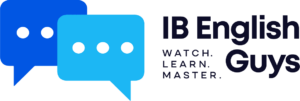

Higher Level Essay
Whether you are an HL Literature student or HL Lang/Lit student, the HLE requires some special attention. The good thing about this assessment is that it’s a processed – rather than on-demand – piece of writing. This means you can take your time, put in the work, and produce something that you love and makes you proud. Our students crush this assessment! Use the same resources they do and enjoy your success.
HLE Writing Guide
Writing this assessment doesn’t have to be challenging. In fact, we think it can be fun and rewarding! Let us guide you through the entire writing process, from line of inquiry to the last word of your conclusion. Our students do well on this assessment, and so can you.

Part of our IBDP English A Student Toolkit , this resource includes:
- 100-page course book with guidance on films, photos, cartoons, and many other non-literary BOWs
- 5 sample papers across genres
- Examiner scores and comments
- Line of Inquiry guidance
- Step-by-step approach to building the HLE in small and manageable chunks
- Complete set of graphic organizers to guide students from start to finish
Developing a Line of Inquiry and Thesis
The Line of Inquiry (LOI) and thesis are the cornerstone of the assessment, so don’t proceed until these are under control. Sadly, many students get off to a poor start with this step, and this means they end up writing either a shallow essay or one that doesn’t really satisfy the requirements of the task. These videos should help you unlock the task.
Start with a text you love and work toward developing a literary or linguistic perspective. Watch this video and start your pathway to success.
How To Write the Line of Inquiry
If the first method didn't work for you, please try another approach.
How to Write the Line of Inquiry (part 2)
Turn that LoI into a clear, precise, and insightful thesis statement that will drive the essay.
HLE Sample Thesis Statements and Writing

The HLE Complete Course from Start to Finish
We feel this is some of our best work. Teachers and students around the world have commented that this HLE series gets the job done and results in some powerful writing that makes students proud. Please take the time and work through the videos sequentially. Work along side with us. Let us guide you to HLE success!
Choose your text and write the LOI.
Student planning doc
Model Student planning doc
Time for brainstorming and outlining.
Student Organizer
Completed Sample Organizer
Master the intro and conclusion.
Sample Intro and Conclusion
Learn how to write strong HLE body paragraphs.
Sample Body Paragraphs
Learn to revise, edit, and polish the final product.
Final instructions before submission
Dave’s complete sample HLE
Some Sample Papers
Sometimes it’s easier to just look at a final product, break it down, and see how other students have approached the HLE. That’s why Dave and Andrew selected some strong papers, highlighted them, and discussed their strengths and weaknesses. We’ve examined tons of these things, so listen carefully. Lots of tips and tricks in these videos to help you pick up some extra points and crack into that mark band you want and deserve. Understand the task. Work hard. Defeat the HLE and allow yourself to beam with pride. Go ahead, you’ve earned it.
You’ve probably noticed that Andrew and Dave love drama. Dialogue, stage directions, props…they’re amazing! Watch our student crush this HLE on Death and the Maiden by Dorfman. What can you steal from this essay in terms of ideas, organization, and overall approach? Document: HLE Student Sample – Drama
Poetry anyone? Andrew and Dave love poetry for the HLE. They are complete “mini works” with a clear beginning, middle, and end. They are rich in techniques. They are complex and have deep meaning. In short, they rock. Just remember that for the HLE, “short texts need friends.” Document: HLE Student Sample – Poetry
Looking For More Support?
Hey, nobody said this thing would be easy. No worries. We’ve got you covered. Perhaps you want to see some more student writing? Check. We’ve got that. Perhaps you want to know some key points to include? Check. We got that too. You’re almost there! Finish these last two videos, add some finishing touches to your work, and submit that baby in with pride and confidence.
So you watched the videos above but are still concerned about “showing deep thinking” on the HLE? It’s ok – we know this is tough. Check out this video to see several samples of how to build big thinking into your writing. Document: Showing Deep Thinking in the HLE
We know, we know. The content is overwhelming and it’s just too much at times. You just want the top ten tips for success? Fine. Here you go. But don’t forget to go back and watch the rest of these videos when you’re feeling more energy. They’re a set. Watch them all and ace the HLE.
IB English Guys
Newsletter signup.
